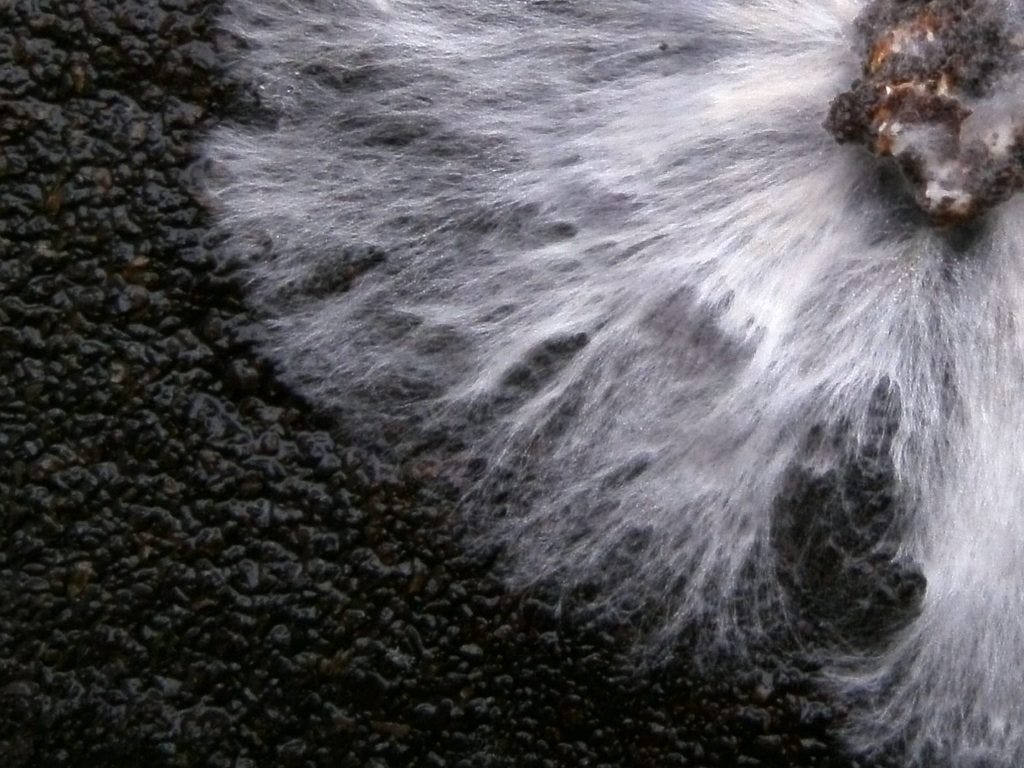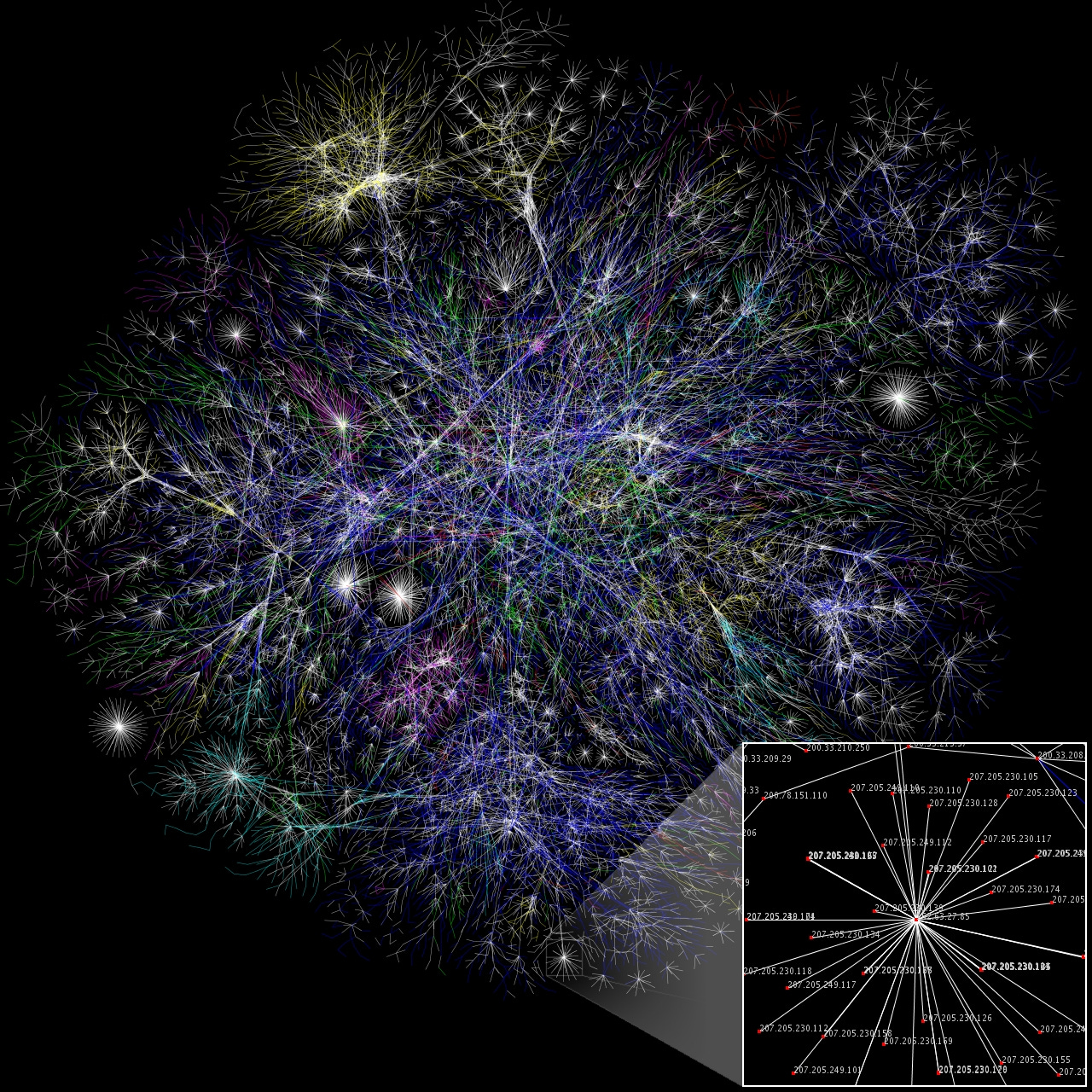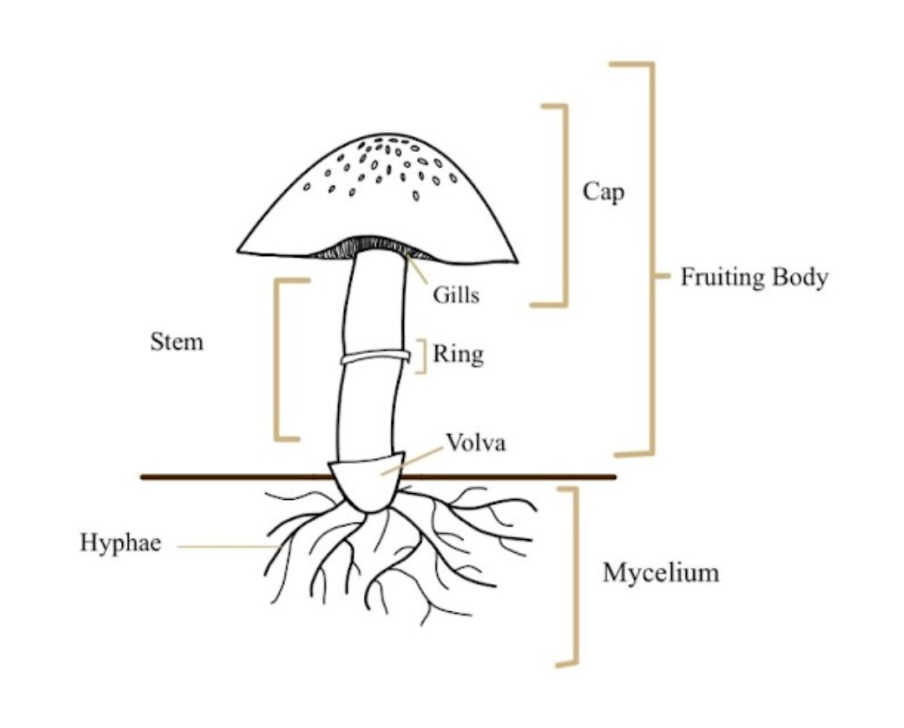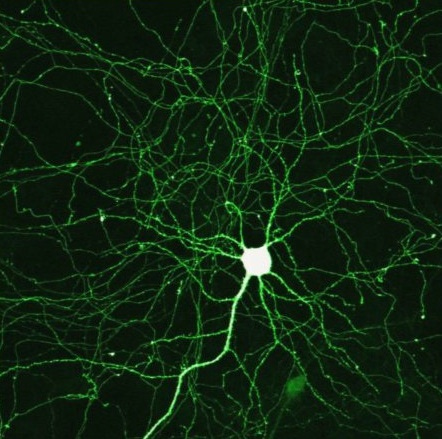A common dream of mine is to set my phone to ‘do not disturb’, run off to the forest, and reconnect with nature. The birds, the trees, the sky, the leaves – the forest teems with activity that looks much different than any Instagram feed. Indeed, there is a secret ecosystem that lies hidden away and forms the foundation for all other forms of life to flourish. However, it seems to behave quite similarly to some of our most used apps. Every time you take a step through a forest, there is an entire social network beneath your feet.
When asked to picture a fungus, most people will think of the cap and stem of a mushroom that grows out of the ground. While these are important, the part of the fungus lying below the ground also greatly contributes to its viability. In fact, what many of us think of as a “mushroom” is actually only the fruiting body1 of a much more complex system.
The subterraneous part of a fungus is known as the mycelium.2 The building blocks of a mycelium are branching, tubular filaments known as hyphae.2 Hyphae grow into a network of filaments which form the mycelium. Mycelium sizes can range from microscopic to the largest living organism on Earth.3 The mycelium is what produces the fruiting bodies (mushrooms, mold, etc.) that we see in our day to day lives.2 However, there is another incredibly important function of the mycelium: communication.
The first level of mycelial communication is within the individual organism itself. Fungi do not have a nervous system like we do, so they must find another way to be aware of their surroundings and understand what different parts of the organism are doing.4 To conceptualize this, we must think of the fungus as a sort of ‘hive mind’. Although the fungus is a singular organism, it is so large that different parts of the fungus will process different environmental cues. The ‘hive mind’ functions because each growing hyphal tip has control over itself, but also a responsibility to the rest of the organism.4 This can occur because each hypha essentially functions as one long cell: each mycelial thread shares its cytoplasm (the liquid that fills the inside of a cell) with all other hyphae.5
Each individual hypha has to find a way to communicate its environmental inputs and its actions to the rest of the fungus. It does this by sharing short ‘messages’ to the rest of the organism; essentially, the organism uses Twitter. These ‘tweets’ can be relayed in a few ways. The most understood mechanism is through the use of a wide range of chemical messengers that diffuse through the mycelium.4 Each chemical corresponds to a different stimulus. Hyphal tips can also pass on messages (retweeting!) by physically fusing with one another to form information pathways.4 Another method of communication functions through the use of electrical impulses, but is less understood by researchers.6
Some scientists believe the electrical impulses we observe in mycelial communication could actually be some form of mushroom “language”.6 Analyses conducted on these electrical impulses revealed that they seem to be used in patterns comparable to human speech.6 The research found that impulses often were used in recognizable ways that could be loosely classified into around 50 “words”, and that the distribution of these “words” reflected that of human languages.6 This is still an emerging field, so it remains to be seen if one day we could translate this “language” and see for ourselves what these mushrooms are posting about.
The second level of communication that the mycelium facilitates is intraspecific; that is, between fungi of the same species. Fungi reproduce sexually, so each must find a mate.4 They use their mycelium to send out chemical signals called pheromones and move towards a potential partner4. Basically, the mycelium also functions as a fungi’s Tinder. When two mycelia meet, they communicate and negotiate what their relationship will look like in the future. This activity can range anywhere from initiating hyphal fusion (a very successful swipe right), to indifference or physical exclusion to prevent fusion (swiped left), to chemical warfare (reported, blocked, threw your phone across the room).4 Through mycelium, a population of fungi can establish long lasting connections with each other and find the perfect partnerships for ecological prosperity.
The final level of a fungi’s ability to communicate through the mycelium is with other non-fungal organisms. For example, tree–fungi interactions. Hyphae can wrap around and bore into tree roots, creating a symbiotic relationship between the fungi & the tree and forming what is known as a mycorrhizal network.1 Many mycologists have affectionately named this network the Wood Wide Web, as it can span acres of forest, connecting multiple organisms (fungi and tree alike) to each other. Personally, I like to think of it more as a mushroom’s LinkedIn, as it forms mutually beneficial connections in its field. The host tree provides energy and shelter for the fungi and in return, the fungi helps with nutrient production.7 Quite interestingly, trees can actually utilize the mycorrhizal network for their own benefit: to “talk” to each other. Researchers have established that trees can send chemical signals through the mycelium for a multitude of different purposes, including warning other trees of danger, or defending themselves against predators or pathogens.7
Mycelium and mycorrhizal networks permeate many living ecosystems and govern critical forms of communication within and between species. Fungi essentially have their own social media app in the form of hyphal interactions. The branching structure of mycelium eerily mimics our neural network, and also interpretations of what the internet’s data cloud looks like. Mycelial interactions show us that everything is connected in some way or another. The next time you are walking in a forest, remember there is a complicated network pulsing with life right underneath the surface of the ground you are walking on. Now that’s something to repost.
The branching structure of mycelium eerily mimics our neural network, and also interpretations of what the internet’s data cloud looks like as shown by the three following images.


References
Holewinski B. Underground Networking: The Amazing Connections Beneath Your Feet - National Forest Foundation [Internet]. Nationalforests.org. 2019. Available from: https://www.nationalforests.org/blog/underground-mycorrhizal-network
The Editors of Encyclopaedia Britannica. Mycelium | fungus filament. In: Encyclopædia Britannica [Internet]. 2019. Available from: https://www.britannica.com/science/mycelium
8.9: Fungi Structure [Internet]. Biology LibreTexts. 2016. Available from: https://bio.libretexts.org/Bookshelves/Introductory_and_General_Biology/Introductory_Biology_(CK-12)/08%3A_Protists_and_Fungi/8.09%3A_Fungi_Structure#:~:text=A%20mass%20of%20hyphae%20make
Hathaway M, Arévalo W. How do fungi communicate? [Internet]. MIT Technology Review. 2023. Available from: https://www.technologyreview.com/2023/04/24/1071363/fungi-fungus-communication-explainer/
Gould AB. Fungi: Plant Pathogenic. Encyclopedia of Microbiology. 2009;457–77.
Geddes L. Mushrooms communicate with each other using up to 50 “words”, scientist claims [Internet]. the Guardian. 2022. Available from: https://www.theguardian.com/science/2022/apr/06/fungi-electrical-impulses-human-language-study
SITNFlash. Exploring The Underground Network of Trees – The Nervous System of the Forest [Internet]. Science in the News. 2019 [cited 2023 Nov 20]. Available from: https://sitn.hms.harvard.edu/flash/2019/exploring-the-underground-network-of-trees-the-nervous-system-of-the-forest/#:~:text=Trees%20have%20a%20symbiotic%20relationship



